|
|
|
Electronics Component Sourcing: Supplier
and device selection guide (part-4)
|
Evaluation and selection of semiconductor IC chips and
other parts and their suppliers
The overall quality and reliability of a product depends
upon the selection of right component from right supplier.
A strong and well-built process can help in selecting a
prospective supplier, A stronger inter-connection between
the different functions and teams is key to successul part
selection.
In this competitive market, the probability for the suppliers
to deviate from the normal-intended procedures to capture
the customers is very high. If these deviations are not
thoroughly validated, there can be serious damages caused
to the products, environment, life, and company's reputation
in one or the other form. Suppliers need customers at any
cost and hence the probability of choosing the right supplier
and their qualification becomes more complex now-a-days.
As said in the introductory
sourcing guide, typically 60% of the finished assembly
consists of components derived or purchased from the companies
other than the original equipment manufacturer (OEM). With
the high percentage of dependency on external suppliers
The risk posed to the OEMs is also high if one does not
choose a proper vendor/supplier. Hence choosing the right
vendor/supplier becomes very much essential for long-term
growth and sustenance.
Supplier selection includes various activities such as researching
the market to locate the right supplier; gathering supplier
information such as their technical abilities and products,
market position, customer support, etc; contracting terms
and agreements; negotiating prices and financial terms;
assessing the suppliers for deviations and thus helping
the suppliers to perform better for mutual growth.
A supplier is the one who delivers a product or a service
in accordance to the order placed by the customer (say an
OEM). The choice of choosing the supplier solely depends
upon the sourcing group in consultation with the design
and other functional teams, if necessary. The other functional
teams help the sourcing group in verifying whether the selected
supplier's product meets the design requirements, their
manufacturability, creation of the Bill-of-Materials (BoMs),
etc.,
It becomes somewhat easy to choose a supplier from the list
of potential suppliers. But the hurdle is how to fetch the
list of prospective suppliers who meet the required criteria.
The procurement/sourcing team's skill play an important
role in addressing this issue. However, for new designs
or NPIs, the design engineers, with their limited knowledge
on known-suppliers, are able to provide the component-supplier
information for the buyers. Additional efforts are required
when the OEMs adopt 'alternate-supplier' strategy - to maintain
the list of other potential suppliers for the given commodity
components excluding custom and single-source components.
As said in the introductory
sourcing guide, the supplier information should be gathered,
stored and updated on a timely basis which is required,
right, recent and reliable to facilitate the overall efficiency
of the procurement process.
Why is the second sourcing important, what is the
necessity of having multiple suppliers, Do major and big
companies only require the supplier database?
Few examples are mentioned below that corresponds to the
real-time situations faced by the engineers demanding the
need for alternate sourcing and the importance of the supplier
database.
a. A failed component in an electronic device is
not available in the market due to its obsolescence (end-of-life).
The engineer has to find a suitable replacement from any
other alternate manufacturer so that the electronic device
is repaired. This is more relevent in high-tech components
such as semiconductor ICs.
b. The insufficient stock of the 'hard-to-find' component
shows poor supply chain management process of a company.
c. The component supplier vanishes from the business
due to bankruptcy or business pressure.
d. Natural calamities like the recent Japan's earthquake
create scarcity of components or wafer substrates and thus
the demand for such components grow abruptly. This is an
opportunity for the grey market suppliers.
e. Low-profit or low sale product line closures by
suppliers and hence no customer-support entertained by the
suppliers.
f. Environmental regulations such as RoHS and their
impact in their specific regions and countries can lead
to the unavailability of the non-RoHS components.
In the above examples, one may notice that the business
is suffered ranging from purchasing the component at a higher
price from the black market to the extent of production
line stoppage.
The business impacts are:
a. Production line stoppages, loss of revenue and
loss of wages.
b. Unhappy customer, damage to brand and lose out
in competition.
c. Budgetary limitations or unplanned budget for
procuring components from open or grey markets.
d. Time and efforts required to research for alternate
components at the neck moment thus promote tremendous pressure
on employees.
e. Abrupt rise in the price of the components due
to the heavy demand.
f. Additional testing overheads (UL, CSA agency requirements)
cause further delay in the release and the significance
is even more when the alternate components have longer lead
times.
In order to overcome these challenges or to recover from
these situations, one has to maintain a second or third
sourcing list to 'be-ready' and 'compliant' against the
above mentioned situations.
To save the business from the unseen, sudden and uncontrollable
losses due to the unavailability of components sourced from
the external suppliers, second sourcing and the supplier
database is very much in need for the successful supply
chain operations for any organisation, big or small. Successful
companies do maintain databases such as AML (Approved Masters
List) or AVL (Approved Vendors List) or Sourcing database,
etc., which may or may not be part of the ERPs. These AMLs
or the AVLs contain the list of alternate suppliers and
the corresponding orderable part numbers for each of the
primary component. In case, the component is a custom or
a speciality component, importance is given to stock such
component in enough quantities that depends upon the estimated
annual usage (EAU) and the product life (in years).
Each company follow a different path to choose and classify
the suppliers based on their specific requirements and supplier
ratings, but the overall intention remains the same across
all the companies. The following list of key factors helps
in selecting potential suppliers.
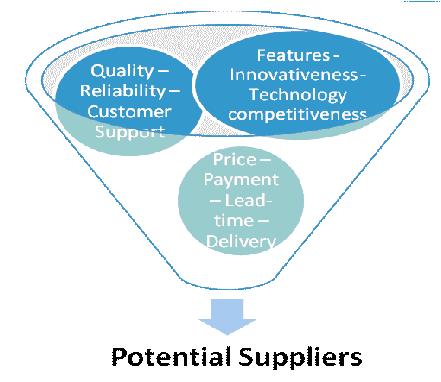
Picture above : Screening funner for potential
suppliers by considering various factors
a. Technology and the innovativeness - product features
and technology uniqueness, patents, joint partnerships with
other leading firms, technology improvements and new product
releases, etc.,
b. Quality, reliability and supply assurance - QMS
Certifications and Quality agreements, field complaints
and failure data, customer rejection data, quality data
from the plant, performance/quality certificates awarded,
etc.,
c. Price, availability and delivery - competitive
price, delivery history, mode of payments and shipments
(payment terms), warehouse location, lead-times, etc.,
d. Regulatory compliance and environmental friendliness
- complying with region, safety and environmental specific
compliances, disposal or recycle methods, non-disclosures
and intellectual property protections, etc.,
e. Customer support and cooperation - process or
product change notices, 24/7 - multilingual customer support
via different means (mail, chat, web, telephonic), support
for surprise audits, etc.,
f. Others - market position, financial strength,
code of ethics, child labour, global presence, etc.,
Once, the list of probable suppliers is gathered, the next
step is to categorize them based on their suitability and
overall credibility. One simple method to classify the suppliers
is to assign appropriate rankings to each one of them based
on the above mentioned individual factors and the information
collected. The ratings can vary between companies based
on their individual requirements.
Picture below: Classifying and choosing
the suppliers through evaluations and negotiations
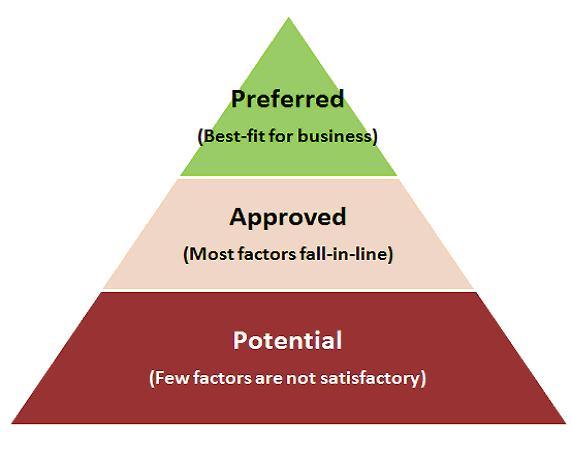
Example: The 5 key factors can be assigned a score which
is based on the importance of the parameter and each supplier
should then be evaluated against these 5 key factors. The
final score obtained for each supplier can be considered
to designate the supplier as potential, approved or preferred.
| Factors |
Score |
Potential |
Approved |
Preferred |
| Technology and Innovativeness |
30 |
16 |
20 |
24 |
| Quality, Reliability and Supply Assurance |
25 |
14 |
16 |
20 |
| Price, Availability and Delivery |
20 |
11 |
13 |
16 |
| Regulatory Compliance and Environmental
Friendliness |
15 |
8 |
10 |
12 |
| Customer Support and Cooperation |
10 |
5 |
7 |
8 |
| Total Score |
100% |
54% |
66% |
80% |
The Potential Suppliers can be classified as the
suppliers which do not satisfy one or more factors and hence
they obtain a percentage of not more than 54%.
The Approved Suppliers are the ones which satisfy
most of the factors and obtain a minimum percentage of 66%
and up to 80%.
The Preferred Suppliers are the suppliers which are
tagged as the best-fit to do the business because their
overall rating at least meets a minimum of 80% and more.
They are the ones which are given the highest priority at
all the times and hence better productivity can be expected.
Note: The ratings and the score given in the above table
is just for illustrative purposes. However, the user can
create a similar score card that suits the individual's
requirements.
With the help of the above factors and the data, the selection
of the suppliers is performed in the order as shown in the
flowchart below. Using the web and other sources, a comprehensive
list of probable suppliers list is formed. Screening or
evaluating the suppliers based on the data (factors) available
gives the list of potential suppliers. Request the information
such as bid data, contract terms, support, sales history,
financial reports, code of ethics, etc., to further scrutinize
the supplier's validity. Price negotiations and entering
into contracts will be the final step in the supplier selection
process. Stronger supplier relationship and positive results
can be achieved by monitoring the performance and effectively
communicating.
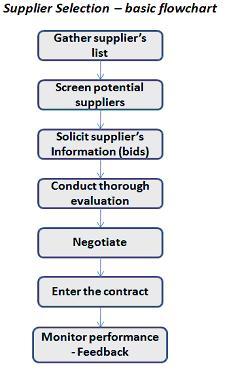
A Supplier database is a comprehensive list of suppliers
and the supplier's information maintained for internal reference
purposes only. The supplier information provides a ready-made
guide for the supply chain, sourcing and design teams to
enrich their productivity. The database at a minimum contains
the supplier's name, contact details and preferred status
(approved, potential, or preferred). The attributes to reside
in the database are company-dependent. The engineers, preferably,
selects the components and services from the preferred suppliers
only as they would have already been evaluated.
For Reference:
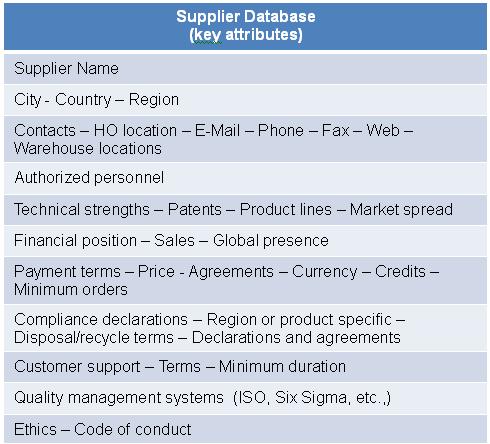
There are several advantages of having a Supplier database
in an organisation (both, big and small sized).
a. Serves as a reference database for the design
engineers to select the suitable components from the distinguished
suppliers and hence less efforts.
b. Consolidation of suppliers can be achieved which
in turn creates cost-saving opportunities.
c. Highly efficient collection and validation of
compliance declarations (Certificates of Conformances, RoHS
certificates, Test reports, and Materials declarations)
can be achieved.
d. Decreases redundant inventory and the associated
budget.
e. Promotes productive supplier management.
f. Lesser then number of suppliers in the active
inventory, lower the risk anticipated.
g. Speeds up the product development cycle.
h. Decreases enormous time and duplicate efforts
of the resources.
i. Smart Inventory and parts management.
j. Strengths and weakness (pros and cons) of the
listed suppliers are thoroughly analysed by the Sourcing
team and hence the repeated analysis efforts are eliminated.
As said earlier, the supplier database is not just specific
to the size or the nature of the organisation. Whoever,
wants to adopt a smarter supplier selection and qualification
process, can develop and maintain a supplier database. The
database can be in any form such as MS-Excel spreadsheet,
MS-Access, Oracle tables, and any similar database.
Thus, selecting suitable suppliers and their effective maintenance
is predominantly dependent on the type of the process, tools
and the databases utilized in the organisation. In other
words, the collective information, as highlighted in the
other modules, plays the vital role in the overall success
of the supplier management and in turn the business itself.
General points:
1. The effective collaboration and communication
with the external suppliers is very important for any successful
supplier partnership.
2. International standard procedures are available
to qualify suppliers and supplier's deliveries.
3. Expectations and requirements should be clearly
set with the suppliers.
4. Audits on a periodic (surprise or pre-determined)
basis with the suppliers promotes mutual growth.
5. Due diligence of the suppliers especially at the
time of business pressures to reduce costs is required.
6. Following the market news regularly is beneficial.
Author:
S Jaya Kumar, Consultant, Component Supply Chain Management
Conatct
him at:

Find below links to other parts of
the article on the same subject of smart component sourcing:
Part1:
Smart component sourcing is about green, clean, rugged,
and the $:The
basics of modern component buying methodologies are explained
in these series of articles.
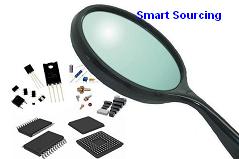
Part2:
Counterfeit components: Methods to protect against fake
parts: Save reputation,
severe loss of time and money by not buying fake parts
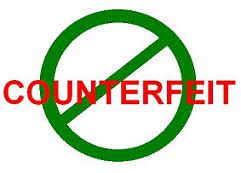
Part3:
Green Component Sourcing through environment conscious part
selection: Selecting
electronic components causing no/least harmful to environment
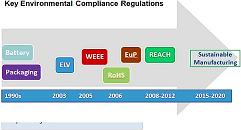
Part
5: The principles and process of electronic component selection:
Component Selection; "an art" for SMART and cost-effective
designs
Part
6: Electronic components Life Cycle management:
Methods to manage sourcing issues of obsolete components
Next: Component lifecycle/obsolescence management (yet
to be published)
|
| |
|
|